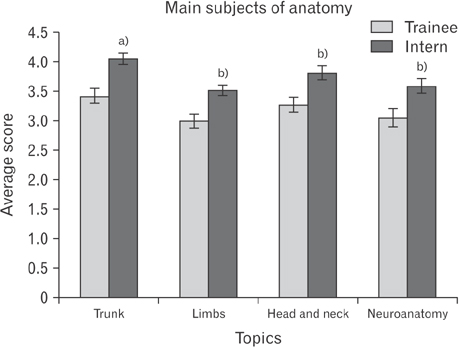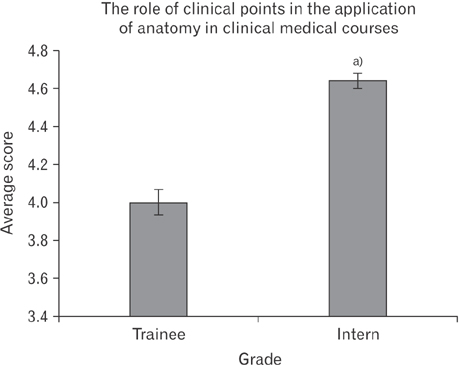Anat Cell Biol.
2017 Sep;50(3):175-179. 10.5115/acb.2017.50.3.175.
Applied anatomy, today's requirement for clinical medicine courses
- Affiliations
-
- 1Department of Anatomical Sciences, Faculty of Medicine, Student Research Committee, Zanjan University of Medical Sciences (ZUMS), Zanjan, Iran.
- 2Ayatollah Mousavi Hospital, Angiography Center, Zanjan University of Medical Sciences (ZUMS), Zanjan, Iran.
- 3Department of Anatomical Sciences, Faculty of Medicine, Zanjan University of Medical Sciences (ZUMS), Zanjan, Iran. reza_nejat@yahoo.com
- 4Department of Biostatistics and Epidemiology, Faculty of Medicine, Zanjan University of Medical Sciences (ZUMS), Zanjan, Iran.
- KMID: 2390478
- DOI: http://doi.org/10.5115/acb.2017.50.3.175
Abstract
- Anatomy as an indispensable part of the medical curricula, offering impeccable knowledge, prepares the students to enter the practical atmosphere. The aim of this study was to evaluate the clinical application of anatomy courses of the medical students in Zanjan University of Medical Sciences. This cross-sectional study was conducted in 2015 with census sampling on all clinical students (trainees and interns). To collect feedback from students, the questionnaire designed by researchers was used. The Likert rating scale of very high, high, medium, low, and very low was considered and scores of 5 (very high) to 1 (very low) were applied. Data were analyzed by SPSS software. Among the courses of anatomy, trunk anatomy has the greatest impact on clinical courses of medical students (P<0.001). Subjects of muscular system, lymphatic system, vascular system, and nervous system were of significant clinical application during clinical periods; however, no significant clinical application observed for skeletal system (P<0.05). Teaching clinical tips by professors can help improve the performance of medical students in clinical education. In addition, using three-dimensional anatomical software is suggested as well.
Keyword
MeSH Terms
Figure
Cited by 1 articles
-
The creation of a body donation program at Federal University of Juiz de Fora in Brazil: academic importance, challenges and donor profile
André Gustavo Fernandes de Oliveira, Augusto Ferreira Gonçalves, Júlia Nunes Soares, Letícia Henriques Neto Salgado, Bruno Silveira Santana, Matheus Venâncio Passos, Juliana Lopes de Oliveira Reis, Gustavo Candiá Arantes, Luís Filipe Sarmento Campos, Matheus Souza Carvalho, Lucas Cotrim Furtado da Gama, Alice Belleigoli Rezende
Anat Cell Biol. 2021;54(4):489-500. doi: 10.5115/acb.21.096.
Reference
-
1. Shariati M, Jafarinaveh H, Bakhshi H. The role of anatomy course in achieving clinical objectives: the viewpoints of Rafsanjan Medical University students in clinical settings. Iran J Med Educ. 2005; 5:176–180.2. Durdi Q, Iman J, Mohsen T. A study of the interns, viewpoints about biochemistry course contents to meet their clinical requirements. J Med Educ Dev. 2011; 4:43–47.3. Fahimi Manzari S, Askarramaki S, Sam S, Pourghasem M. Effective methods on teaching and learning of anatomy course. Eudc Stragety Med Sci. 2013; 6:95–99.4. Pourghasem M, Sum S. Practical anatomy as an advance organizer for anatomy lectures: effectiveness in learning facilitation for dental students. Iran J Med Educ. 2011; 11:478–484.5. Bay BH, Ling EA. Teaching of anatomy in the new millennium. Singapore Med J. 2007; 48:182–183.6. Atlasi MA, Naderian H, Mousavi G. Effect of anatomy practice background on quality of anatomy education. Feyz. 2000; 4:17–22.7. Kaimkhani ZA, Ahmed M, Al-Fayez M, Khoshhal K, Zafar M, Javaid A. Does the existing traditional undergraduate anatomy curriculum satisfy the senior medical students? A retrospective evaluation. South East Asian J Med Educ. 2010; 3:20–26.8. Mehralizadeh S, Pourhoseini M, Vakili A, Ghorbani R, Zolfaghary S. Factors affecting learning of anatomy: students' viewpoints. Iran J Med Educ. 2013; 13:49–57.9. Patel KM, Moxham BJ. Attitudes of professional anatomists to curricular change. Clin Anat. 2006; 19:132–141.10. Pangaro LN. A shared professional framework for anatomy and clinical clerkships. Clin Anat. 2006; 19:419–428.11. Reidenberg JS, Laitman JT. The new face of gross anatomy. Anat Rec. 2002; 269:81–88.12. Lockwood AM, Roberts AM. The anatomy demonstrator of the future: an examination of the role of the medically-qualified anatomy demonstrator in the context of tomorrow's doctors and modernizing medical careers. Clin Anat. 2007; 20:455–459.13. Older J. Anatomy: a must for teaching the next generation. Surgeon. 2004; 2:79–90.14. Jones DG. Anatomy departments and anatomy education: reflections and myths. Clin Anat. 1997; 10:34–40.15. Cottam WW. Adequacy of medical school gross anatomy education as perceived by certain postgraduate residency programs and anatomy course directors. Clin Anat. 1999; 12:55–65.16. Patel KM, Moxham BJ. The relationships between learning outcomes and methods of teaching anatomy as perceived by professional anatomists. Clin Anat. 2008; 21:182–189.17. Taghavi MM, Vazeirinejad R, Shamsizadeh A, Shariati KM. Evaluation of medical student's learning of anatomical subjects by using a compound method and in comparison with traditional method. J Iran Anat Sci. 2011; 9:170–177.
- Full Text Links
- Actions
-
Cited
- CITED
-
- Close
- Share
- Similar articles
-
- Aristotelian Philosophy in Its Bearing on Anatomical Thought
- Learning styles and strategies preferences of Iranian medical students in gross anatomy courses and their correlations with gender
- Global health curricula in Korean nursing schools: Focusing on the changes since 2015
- Analysis of Korea-Massive Open Online Courses in medical and dental education
- A Brief Review of Anatomy Education in Korea, Encompassing Its Past, Present, and Future Direction



